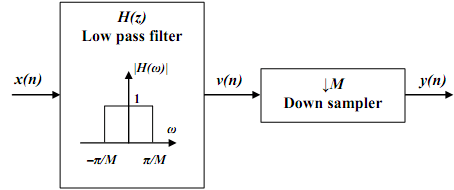This set of Digital Signal Processing Multiple Choice Questions & Answers (MCQs) focuses on “Decimation by a Factor D”.
1. If we down-sample a signal x(n), then the resulting signal will be an aliased version of x(n).
a) True
b) False
View Answer
Explanation: We know that if we reduce the sampling rate simply by selecting every Dth value of x(n), the signal will be an aliased version of x(n).
2. What is the folding frequency for the aliased version of x(n) with sampling rate F?
a) F/D
b) F/4D
c) F/2
d) F/2D
View Answer
Explanation: We know that if we reduce the sampling rate simply by selecting every Dth value of x(n), the signal will be an aliased version of x(n), with a folding frequency of F/2D.
3. To what value should the bandwidth of x(n) has to be reduced in order to avoid aliasing?
a) F/D
b) F/2D
c) F/4D
d) None of the mentioned
View Answer
Explanation: To avoid aliasing, we must reduce the bandwidth of x(n) to Fmax=F/2D. Then we may down-sample by D and thus avoid sampling.
4. Which process has a block diagram as shown in the figure below?

a) Sampling rate conversion
b) Interpolation
c) Decimation
d) None of the mentioned
View Answer
Explanation: The block diagram shown in the figure is of sampling rate conversion by decimation by a factor D technique.
5. Which of the following is true about the filtering operation on x(n)?
a) Linear
b) Time variant
c) None of the mentioned
d) Linear and time invariant
View Answer
Explanation: Although the filtering operation on x(n) is linear and time invariant, the down-sampling operation in combination with the filtering results in a time variant system.
6. If x(n) produces y(m), then x(n-n0) does imply y(n-n0) for any value of n0.
a) True
b) False
View Answer
Explanation: Given the fact that x(n) produces y(m), we note that x(n-n0) does not imply y(n-n0) unless n0 is a multiple of D.
7. The linear filtering operation followed by down sampling on x(n) is not time invariant.
a) True
b) False
View Answer
Explanation: Given the fact that x(n) produces y(m), we note that x(n-n0) does not imply y(n-n0) unless n0 is a multiple of D. Consequently, the overall linear operation, that is linear filtering followed by down sampling on x(n) is not time invariant.
8. Which of the following gives the equation for y(m)?
a) v(mD)
b) p(mD)
c) v(mD).p(mD)
d) none of the mentioned
View Answer
Explanation: We know that the equation for y(m) is given as
y(m)= \(\bar{v}(mD)\)= v(mD).p(mD).
9. We need not relate the spectrum of y(m) to spectrum of x(n) to obtain frequency response characteristic of y(m).
a) True
b) False
View Answer
Explanation: The frequency domain characteristic of the output sequence y(m) can be obtained by relating the spectrum of y(m) to the spectrum of the input sequence x(n).
10. The sequence \(\bar{v}(n)\) can be obtained by multiplying v(n) with a signal p(n) of period D.
a) True
b) False
View Answer
Explanation: \(\bar{v}(n)\) can be viewed as a sequence obtained by multiplying v(n) with a periodic train of impulses p(n) with period D.
11. If HD(ω) is the frequency response of the low pass filter, then for what value of ω, HD(ω)=1?
a) |ω| = π/D
b) |ω| ≥ π/D
c) |ω| ≤ π/D
d) None of the mentioned
View Answer
Explanation: The input sequence x(n) is passed through a low pass filter, characterized by the impulse response h(n) and a frequency response HD(ω), which ideally satisfies the condition,
HD(ω)=1, |ω| ≤ π/D
=0, otherwise.
12. The filter eliminates the spectrum of X(ω) in the range π/D < ω < π.
a) True
b) False
View Answer
Explanation: The input sequence x(n) is passed through a low pass filter, characterized by the impulse response h(n) and a frequency response HD(ω), which ideally satisfies the condition,
HD(ω)=1, |ω| ≤ π/D
=0, otherwise
Thus the filter eliminates the spectrum of X(ω) in the range π/D < ω < π.
Sanfoundry Global Education & Learning Series – Digital Signal Processing.
To practice all areas of Digital Signal Processing, here is complete set of 1000+ Multiple Choice Questions and Answers.
If you find a mistake in question / option / answer, kindly take a screenshot and email to [email protected]
